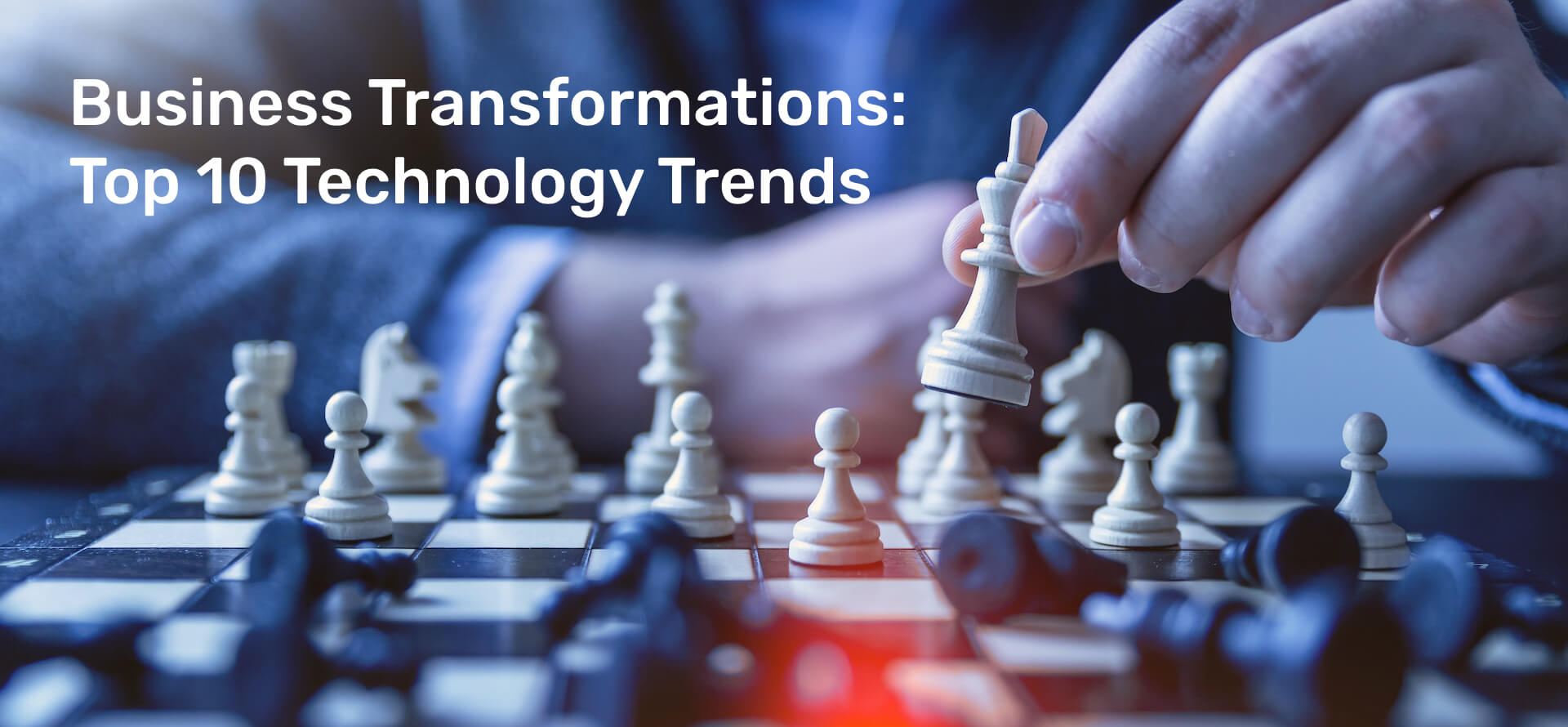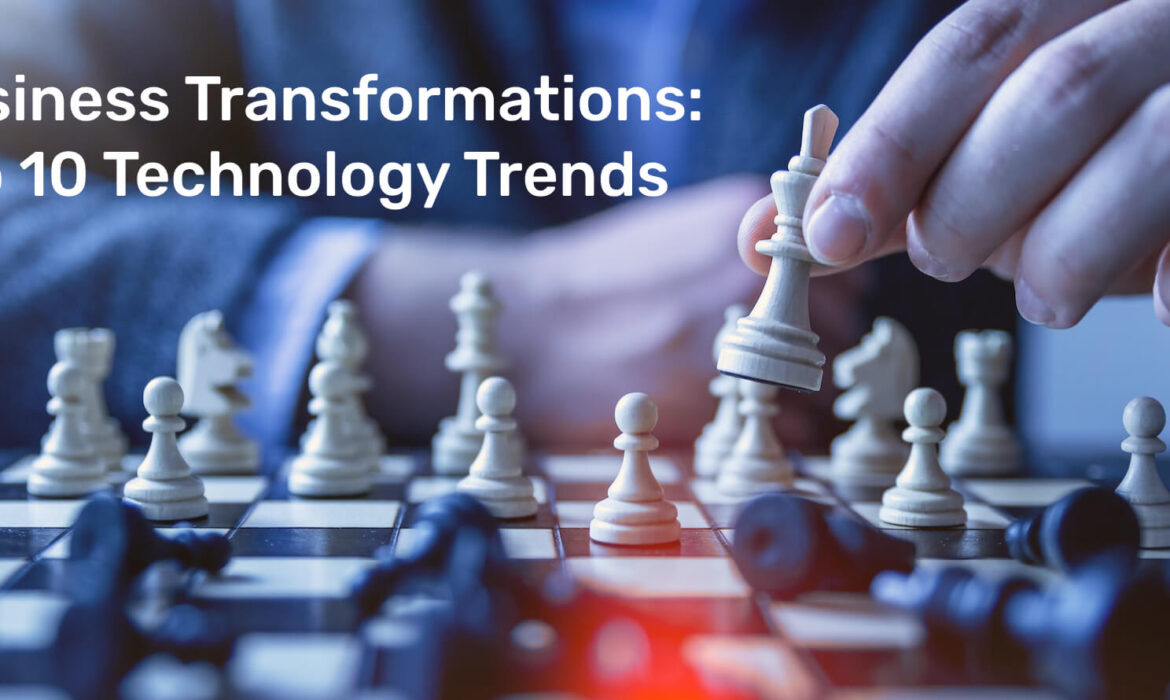In today’s fast-paced digital landscape, businesses must adapt to technological advancements to stay competitive. But with so many new technologies emerging, it can be difficult for business leaders to know where to focus their investments. We’ll explore the top 10 technology trends driving business transformations today, providing data-driven insights to help organizations navigate the changing technological landscape.

In today’s fast-paced digital landscape, businesses must adapt to technological advancements to stay competitive. But with so many new technologies emerging, it can be difficult for business leaders to know where to focus their investments. In this article we’ll explore the top 10 technology trends driving business transformations today, providing data-driven insights to help organizations navigate the changing technological landscape.
1. Generative AI: Closing the gap between information and insight
Data has become the lifeblood of organizations, driving critical decision-making processes and providing valuable insights. According to IDC, the global datasphere is projected to grow from 64.2 zettabytes in 2020 to 180 zettabytes by 2025. This exponential growth necessitates robust data infrastructure and analytics capabilities to effectively harness and utilize data for business transformation.
Businesses are investing heavily in data lakes, data warehouses, and advanced analytics tools to handle the ever-increasing volume, velocity, and variety of data. By leveraging machine learning algorithms and artificial intelligence, organizations can derive actionable insights from vast datasets, enabling data-driven decision-making and competitive advantage. Before Gen AI, the level of investment needed to have sophisticated insights, human-centered experiences, and story-telling was cost-prohibitive for a lot of organizations. Unimaginable? That was so yesterday.
2. The shift from cloud native to data native: Cloud adoption for large data workloads
Historically, large data workloads have presented challenges when migrating to the cloud due to scalability and performance concerns. However, the advent of cloud-native data platforms has revolutionized the landscape. Snowflake, Redshift, and Azure Synapse are leading cloud-based data warehousing solutions that offer elastic scalability, high-performance analytics, and cost optimization.
Organizations are increasingly adopting these cloud-based solutions to harness the benefits of scalability, agility, and cost efficiency. According to Oracle, more than half of all databases have been deployed in, or migrated to, a cloud platform. This shift has allowed businesses to leverage the power of cloud computing and handle large data workloads seamlessly, unlocking the full potential of their data assets.
3. A resurgence of data mesh in a multicloud context
Data mesh, an architectural approach that emphasizes decentralization and democratization of data, is gaining momentum, especially in multicloud environments. With organizations adopting multiple cloud providers to take advantage of their unique capabilities, data mesh provides a scalable and flexible data architecture that facilitates cross-functional collaboration.
By treating data as a product, data mesh encourages domain-oriented ownership, empowering individual teams to take responsibility for their data products. This approach enables organizations to overcome challenges related to data silos and fosters a culture of collaboration and data-driven decision-making across the enterprise.
4. The strategic importance of AI and cautious execution
As we shared earlier, artificial intelligence (AI) has become a strategic imperative for businesses across industries. According to IDC, worldwide spending on AI is expected to reach $300 billion by 2026. Boards and CEOs recognize the transformative potential of AI in enhancing customer experiences, optimizing operations, and driving innovation.
However, cautious execution is crucial to address concerns related to the pace of change, data privacy, and ethics. Organizations must establish robust governance frameworks, ethical guidelines, and data privacy policies to ensure responsible AI deployment. By striking a balance between innovation and ethical considerations, businesses can fully harness the potential of AI and build trust with their customers.
5. Modular incremental transformations
While this is not exactly a new trend, the current economic conditions have made it stand out. Long, multiyear transformation programs are being replaced by modular incremental transformations that deliver tangible results faster. This shift allows organizations to implement changes in smaller, more manageable phases, reducing risks and ensuring a smoother transition.
Numerous studies show the vast majority of executives prefer modular transformations that provide value incrementally. This approach enables businesses to adapt quickly to changing market dynamics and customer demands. By breaking down transformation initiatives into smaller modules, organizations can iterate on their strategies based on real-time feedback, continuously improving processes, products, and services.
6. Integration of best-of-breed applications over ERP
Traditional enterprise resource planning (ERP) systems are no longer the sole focus of organizations’ technology landscapes. Instead, businesses are increasingly adopting best-of-breed applications, which are specialized software solutions designed to address specific business functions or industry verticals.
The rise of cloud computing and application programming interfaces (APIs) has made it easier to integrate and orchestrate diverse applications. This integration allows organizations to leverage the strengths of each application, creating a more agile and efficient technology ecosystem. For example, a company may choose a customer relationship management (CRM) solution, a human resources management (HRM) tool, and a supply chain management (SCM) system that best fit their specific needs, integrating them seamlessly to drive operational excellence.
7. COTS and low-code/no-code applications
The landscape of application development is evolving rapidly, with the rise of commercial off-the-shelf (COTS) solutions and low-code/no-code platforms. COTS solutions offer prepackaged software applications that can be customized to suit specific business requirements. On the other hand, low-code/no-code platforms enable nontechnical users to build applications with minimal coding, using visual interfaces and drag-and-drop functionality.
The flexibility and speed of implementation offered by COTS solutions and low-code/no-code platforms have significantly reduced development cycles and empowered business users to drive innovation. Gartner predicts that, by 2024, low-code application development will be responsible for more than 65% of all application development activity.
8. Advancements in IoT/sensor technology for digital twins
The Internet of Things (IoT) and sensor technology advancements are revolutionizing the concept of digital twins. A digital twin is a virtual representation of a physical object or system that provides real-time data and insights. By creating a digital replica, organizations can monitor, analyze, and optimize the performance of physical assets, processes, and environments.
With advancements in IoT and sensor technology, digital twins are becoming more sophisticated and capable of delivering valuable insights. For example, in the manufacturing industry, IoT-enabled sensors can monitor equipment health, detect anomalies, and optimize maintenance schedules. By leveraging digital twins, organizations can enhance operational efficiency, reduce downtime, and drive innovation through predictive maintenance and performance optimization.
9. Increased investments in sustainability
Sustainability has emerged as a key priority for businesses, driven by environmental concerns, regulatory requirements, and customer expectations. According to the World Economic Forum, 90% of executives believe that sustainability is important for long-term business success.
Measuring and reducing carbon footprint has become a crucial aspect of sustainability initiatives. Organizations are investing in technologies that enable accurate measurement, monitoring, and reporting of carbon emissions. Advanced analytics and AI-powered tools help organizations identify areas for improvement, optimize resource utilization, and make informed decisions to reduce their environmental impact.
10. Convergence of RPA and system integration technologies
Robotic process automation (RPA) and system integration technologies are converging to provide comprehensive automation solutions across the enterprise. RPA automates repetitive and rule-based tasks, while system integration technologies connect disparate systems and enable seamless data flow and process orchestration.
By combining these technologies, businesses can achieve end-to-end automation, streamlining processes and eliminating manual intervention.
Conclusion
From harnessing the power of data and the cloud to embracing AI responsibly, organizations must adapt to these trends to stay competitive and drive innovation. By leveraging the potential of emerging technologies, businesses can optimize processes, deliver exceptional customer experiences, and position themselves for success in the rapidly evolving digital landscape.
